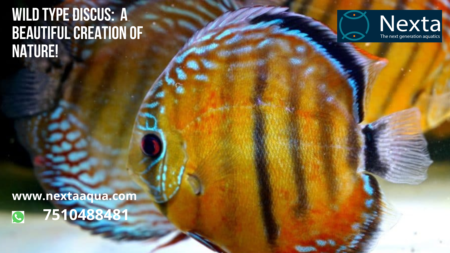One of the aquarium hobbyist’s favorite fish is wild type discus.
Wild type discus is found mainly in tropical regions of South America.
They are very easy to take care of and do not require a lot of attention from their owner or keeper.
These species can reach sizes up to 8 inches (20 cm) long, but most will be seen around 5 to 6 inches (13-15 cm).
They have an average lifespan in captivity of 15 years with proper care.
Wild discus is also known as silver dollar discus or blueberry discus.
ALSO READ: Discus the Best Fish for Home Aquariums
Whatever you call them, these colorful creatures are one of your best bets when getting into keeping aquatic animals and plants.
Wild type discus ranges widely in colors and patterns depending on where they come from geographically (in other words, their wild coloration).
For example a wild type red haired variety comes from Brazil, while another red haired variety comes from Central Africa and has a much different pattern than its Brazilian cousin.
Wild type discus and the importance of wild discus and its lifestyle, in an aquarium setting, are discussed below. Wild type discus is much different than the man-made type of discus. You may have heard about this in the past or even seen documentaries or articles about them, but what does it mean to have wild type fish in your aquarium? What do you need to know about these fish? How can you keep them in your tank? The below section will answer all your doubts.
Importance of Wild Type Discus
Wild type discus must be brought into captivity in order to preserve its species.
This is important because if we left wild discus as they are, they would likely become extinct due to our influence on their ecosystem.
Without us around, they wouldn’t have any threats, but also wouldn’t be able to get food.
As such, it is our duty to make sure that these fish are well taken care of so that their species doesn’t go extinct.
Many scientists say that more than half of all fish in water tanks today come from a place where they aren’t supposed to be; hopefully we can help fix some of these issues by breeding wild type discus and releasing them back into nature once again.
ALSO READ: Aesthetic Aquarium Plants for Your Home

Benefits of Wild Type Discus
Freshwater Aquarium fish are very delicate creatures.
They require regular feeding, clean water, a safe environment, good filtration and low stress to thrive.
So it is important that you select fish that can live in your freshwater aquarium environment.
Wild type Discus is wild caught from pristine forest pools where they have had no contact with chemical medications or pathogens.
These fish do not require any chemical treatments when kept in aquariums.
In fact, by keeping them in a stable ecosystem that mimics their natural habitat there is little need for any additions to their environment other than quality food and water changes as required?
ALSO READ: Discus Fish Care Feeding
Compatibility with Domesticated Types
Wild discus is actually compatible with domesticated types.
However, wild discus are much harder to breed and raise than their domesticated counterparts.
But when breeding them, one needs to have knowledge about both wild discus as well as domestic types.
They differ from each other in many ways like diet, type of environment they live in, among others.
Domesticated discus prefers a temperature level between 78 degrees Fahrenheit (25 Degrees Celsius) to 80 degrees Fahrenheit (26 degrees Celsius).
On the other hand, it require warm temperatures similar to those of South America; however, not exceeding the required temperature (38 Degrees Celsius).
So it is essential that you understand your pet properly before purchasing them for yourself or for anyone else.
Feeding and Water Requirements
Wild type discus is usually found in fast-flowing rivers, but can also be found in lakes and ponds.
Wild discus feed on a variety of small fish, insects, and other aquatic life forms.
They can live in waters with very little oxygen content due to their highly evolved respiratory systems.
Because they are captured at such young ages and raised in domestic aquariums, wild discus must learn how to handle a completely new environment once introduced into your tank.
Their diet is based on wild caught insects like dragonflies as well as spiders, grubs, small fish such as dace (barbs), perch or gudgeon; not much has been documented about their feeding habits beyond these few known facts.
ALSO READ: What Do Discus Fish Eat?

Temperature Requirements
Discus is growing in many different environments but it prefers a temperature around 79°F.
This is an important factor to consider when keeping wild type discus; you should maintain a water temperature that’s consistent with their natural habitat.
If you don’t do so, your discus will become stressed and its immune system compromised—which can lead to disease.
While wild discus may be able to adapt to certain temperatures (such as hotter or colder temperatures), doing so may decrease their lifespan.
Making sure your wild discus has ideal conditions isn’t just about matching its current environment: It’s also about setting it up for future success.
By mimicking optimal environmental conditions (such as pH levels), wild discus that live longer have more time for growth and breeding, which improves fertility rates.
Ideally, you want high fertility rates because fertile eggs increase survival rates for both juveniles and adults by 25 percent!
That’s why finding a healthy group of captive-bred juveniles from a reputable source is essential if you want to keep them in aquarium tanks.
ALSO READ: How Big Do Discus Fish Get?
Breeding Wild Type Discus Fish
Captive-bred discus is becoming more popular in aquariums, with some hobbyists preferring them to wild type discus.
In fact, it is thought that if left to its own devices, discus would be able to spawn successfully in a well-planted home aquarium.
With regular water changes and keeping ammonia levels as low as possible by doing frequent partial water changes, captive breeding can be a successful venture.
However, there are also several concerns that must be addressed when it comes to breeding them in an aquarium setting.
If a hobbyist wishes to keep wild type discus he or she will have to first research species compatibility and choose proper tank mates carefully.
One should always remember that wild-type discus kept together tend to fight, especially during breeding season (which occurs between April and June).
If you want wild type discus fish in your tank you’ll have to make sure they are compatible with one another before purchasing them.
While choosing tank mates for your group of wild-type discus, look for other active species that prefer similar environmental conditions.
ALSO READ: Guide on Discus Fish Tank Mates
Last Word about Wild Type Discus
There are many wild discus that live in lakes, creeks, streams.
They can be found in a range from South America to Africa.
Wild discus is not easy to keep in aquariums because they require a large amount of food daily and need plenty of oxygen.
These fish need to be put into quarantine tanks when first introducing them into an aquarium or pond because they may spread disease to other fish.
It is important to read up on how you care for your wild type discus so you will know what kind of diet they will require as well as what types of water parameters are required by these fish.
If done correctly, wild type discus can thrive in captivity but some may die quickly due to improper care given by inexperienced aquarists.
Nextaaqua is a unique ornamental fish farm in India. We mainly focus on the production, raising, and grooming of Discus Fishes and their tankmates. Contact us for more.



